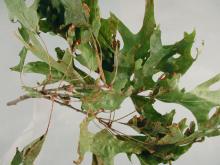Cause Apiognomonia errabunda, a fungus widespread and common in western Washington, Oregon, and coastal British Columbia and found occasionally in eastern Washington. It is of little significance most years but can be serious in prolonged moist weather in spring and summer. Large trees can sustain severe disease without permanent damage. The disease can be a problem in production nurseries growing susceptible species.
White oak (Quercus alba) is highly susceptible. The fungus is commonly found as an endophyte of Oregon white oak (Q. garryanna) yet it rarely causes any disease on this host. Juvenile leaves are most susceptible to infection and become resistant as they enlarge and age. Wet rainy weather favors spore distribution and infection during bud break and early shoot growth. The fungus overwinters in leaf debris, twigs, stems and cankers.
Symptoms Scattered brown spots or brown dead areas develop on leaves, commonly along veins. Severely affected leaves may curl, pucker, or twist down. Defoliation may occur. The fungus may invade the twigs, causing small cankers and possible twig dieback.
Cultural control
- Rake and destroy fallen leaves.
- Prune out and destroy diseased and dead branches.
- Increase spacing in nursery production.
Chemical control
- If needed, use in spring during budbreak and early shoot growth when wet weather is expected. For certain species with marcescent leaves, bud break is close when brown leaves retained during the winter drop from the tree. To reduce the possibility of resistant fungi, alternate or tank-mix sprays of fungicides with different modes of action.
- Armada 50 WDG at 3 to 9 oz/100 gal water. Do not use a silicone-based surfactant. Not for nursery or greenhouse use. Group 3 + 11 fungicide. 12-hr reentry.
- Banner MAXX is labeled for oak at 16 oz/100 gal water. Growth regulation will occur in the form of smaller, darker leaves and compact growth. Group 3 fungicide. 12-hr reentry.
- Bonide Fung-onil Multi-purpose Fungicide at 2.25 teaspoons/gal water. H
- C-O-C-S WDG at 3.9 lb/A plus 2 lb hydrated lime/100 gal water. Group M1 fungicide. 48-hr reentry.
- CuPRO 5000 at 1.5 to 5 lb/A but only up to 2 lb/A when new growth is present. Group M1 fungicide. 48-hr reentry.
- Daconil Weather Stik at 1.38 pints/100 gal water for red oaks only. Group M5 fungicide. 12-hr reentry.
- Mancozeb-based products. Group M3 fungicides. 24-hr reentry.
- Fore 80 WP at 1.5 lb/100 gal water plus a spreader-sticker.
- Protect DF at 1 to 2 lb/100 gal water plus 2 to 4 oz spreader-sticker.
- Orkestra at 8 to 10 fl oz/100 gal water. Group 7 + 11 fungicide. 12-hr reentry.
- Ortho MAX Garden Disease Control at 2 teaspoons/gal water. H
- Spectro 90 WDG at 1 to 2 lb/100 gal water. Group 1 + M5 fungicide. 12-hr reentry.
- Thiophanate-methyl-based products plus another fungicide. Group 1 fungicide. 12-hr reentry.
- Cleary's 3336 EG at 12 to 16 oz/100 gal water.
- OHP 6672 4.5 F at 10.75 to 20 fl oz/100 gal water.
- Torque at 4 to 10 fl oz/100 gal water. Group 3 fungicide. 12-hr reentry.
- Tourney EZ at 1 to 4 oz/100 gal water. Group 3 fungicide. 12-hr reentry.
- A few chemicals are registered for tree injection as a preventative treatment. Do not inject trees less than 2 inches in diameter or that are suffering from various stresses.
- Fungisol; see label. Group 1 fungicide. Washington and Idaho only.
- Phyton 27; see label. Group M1 fungicide.
- Tebuject 16 is registered for tree injections. The number of capsules used is based on tree size. Group 3 fungicide.
Note Some registered products offer only suppression of this disease and thus are not recommended for use. These products include Phospho-Jet.
References Sinclair, W.A. and Lyon, H.H. 2005. Diseases of trees and shrubs, 2nd ed. Cornell University Press.
Wilson, D. and Carroll, G.C. 1994. Infection studies of Discula quercina, an endophyte of Quercus garryanna. Mycologia 86:635-647.






